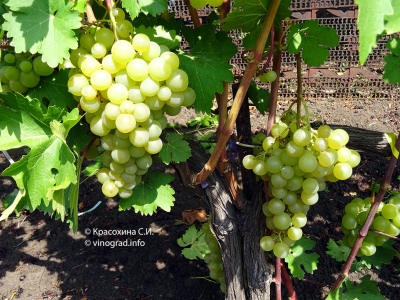
- Authors: G.E. Westmins, Latvia
- Appointment: dining room
- Berry color: White
- Taste: harmonious
- With bones: Yes
- Ripening period: very early
- Ripening period, days: 92-98
- Frost resistance, ° C: -24
- Bunch weight, g: 200-250
- Flower type: bisexual
The name of Dovga grapes can tell a lot to connoisseurs. But novice winegrowers should definitely get acquainted with the nuances of this culture. And an important role is played by information about its cultivation and ripening time, about the consumer properties of the fruit.
Breeding history
The Dovga variety is of Latvian origin. Breeding work on it was carried out by G.E. Westminsh. This is a hybrid of a complex composition, which was obtained by:
V. vinifera;
V. amurensis;
Muscat de Saint-Valier;
a mixture of pollen especially from early grape varieties.
Description
Ripening period
Dovga grapes belong to a particularly early category. Between planting and collection of ready-to-eat berries normally take from 92 to 98 days. It is these achievements that make it possible to recommend this plant for growing in areas with a relatively harsh climate. In the south of the Moscow region, the harvest time begins at the end of July. By the beginning of August, Dovga is harvested in the Baltic countries, and by the middle of the month, the harvesting season begins in the Tver region.
Bunches
In Dovga grapes, the brushes represent a cross between a cone and a cylinder. Inside them, the berries are grouped moderately densely. The mass of one bunch is in most cases 200-250 g. It is difficult to say that this is an outstanding result. But for rather cold areas, it is quite acceptable.
Berries
Dovga grapes are white in color. They contain bones inside. The presence of 2-3 seeds is typical. Other features:
round shape of the fruit;
weight from 5 to 6.5 g;
the size of the berries is 2.6x2.8 cm (that is, they are not too dense in comparison with the harvest of other varieties).
Taste
In the description of the variety, a harmonious taste is mentioned. But this is such a frequent wording that it says little. The plant is favored by the high sugar content, reaching 190-220 g per 1 dm3. The pulp of Dovga fruit is tender and pleasant. It should be noted that its taste can vary depending on various conditions.
Yield
The fruiting factor is 0.7-0.8. Of course, there are also more active grapes. But here, again, it is necessary to make allowances for the northern origin of the variety.


Growing features
Landing
Although the variety is frost-resistant, it is better to wait until the frost is over. The early ripening period allows you especially not to rush. Sunlight is equally important for all varieties.

Pollination
The bisexual flowers typical of the Dovga variety allow you not to worry about this procedure at all. Only in problematic conditions will it be necessary to perform it manually. But even inexperienced gardeners are unlikely to face such a problem.
Pruning
The variety is characterized by strong intensive growth. Therefore, at least it will be very difficult to do without normalizing pruning. You need to cut the vine by 7-8 eyes.1 bush can develop from 40 to 50 eyes. The precautions are the same as for other fruit plants.



Frost resistance and the need for shelter
Declared resistance to cold up to -24 degrees. However, this is completely insufficient for confident wintering in the conditions of central Russia. There is no question of more difficult climatic regions. The shelter measures are nothing particularly original. Breathable natural shelters are preferred over synthetic ones.

Diseases and pests
Dovga grapes can suffer from attacks by wasps. Therefore, all their nests should be destroyed immediately. An important preventive measure is tissue bags. Mildew resistance is 3 points. Information regarding other pests and diseases in open sources has not yet been given.

If a grape is exposed to any disease or insect, this always affects its appearance.
Storage
Dovgi's harvest can hang on the bush for up to 30 days. The main thing is that at this moment it is not damaged by horseflies. There are no special requirements for the preservation of fruits in comparison with other types of grapes. However, due to the pronounced taste, the storage problem does not arise often at all.











































































